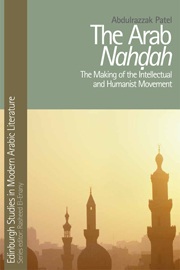Book contents
- Frontmatter
- Contents
- Series Editor's Foreword
- Acknowledgements
- Preface
- Introduction: Perspectives, Paradigms and Parameters
- 1 Contemporary Interpretations of the Nahḍah: Tradition, Modernity and the Arab Intellectual
- 2 The Reintegration of Pre-modern Christians into the Mainstream of Arabic Literature and the Creation of an Inter-religious Cultural Space
- 3 Guardians of the Pre-modern Arab-Islamic Humanist Tradition: Legends without a Legacy, a Tradition without Heirs
- 4 Language Reform and Controversy: The al-Shartūnīs Respond in Defence of the Pre-modern Humanist Tradition
- 5 Arabism, Patriotism and Ottomanism as Means to Reform
- 6 Arab Intellectuals and the West: Borrowing for the Sake of Progress
- 7 Education, Reform and Enlightened Azharīs
- 8 Enacting Reform: Local Agents, Statesmen, Missionaries and the Evolution of a Cultural Infrastructure
- Conclusion
- Bibliography
- Index
8 - Enacting Reform: Local Agents, Statesmen, Missionaries and the Evolution of a Cultural Infrastructure
Published online by Cambridge University Press: 05 October 2013
- Frontmatter
- Contents
- Series Editor's Foreword
- Acknowledgements
- Preface
- Introduction: Perspectives, Paradigms and Parameters
- 1 Contemporary Interpretations of the Nahḍah: Tradition, Modernity and the Arab Intellectual
- 2 The Reintegration of Pre-modern Christians into the Mainstream of Arabic Literature and the Creation of an Inter-religious Cultural Space
- 3 Guardians of the Pre-modern Arab-Islamic Humanist Tradition: Legends without a Legacy, a Tradition without Heirs
- 4 Language Reform and Controversy: The al-Shartūnīs Respond in Defence of the Pre-modern Humanist Tradition
- 5 Arabism, Patriotism and Ottomanism as Means to Reform
- 6 Arab Intellectuals and the West: Borrowing for the Sake of Progress
- 7 Education, Reform and Enlightened Azharīs
- 8 Enacting Reform: Local Agents, Statesmen, Missionaries and the Evolution of a Cultural Infrastructure
- Conclusion
- Bibliography
- Index
Summary
Besides the writing of pedagogical works and the printing of Arabic classics and original works, Arab thinkers believed that the establishment of a strong cultural infrastructure was necessary to introduce, promote and facilitate the learning of imported modern Western and native revived knowledge at all levels of society. Building on the previous section on education, this chapter describes a rapidly expanding cultural infrastructure of schools, presses, periodicals and societies that emerged in the later part of the nineteenth century with a particular focus on Lebanon. The chapter also highlights the role of nahḍah intellectuals and humanists who supplied this infrastructure through a life-time of teaching and scholarly activities, while drawing attention to the role of the Christian missionaries who made important contributions to its development in the last quarter of the nineteenth century.
Transforming the Educational Landscape in Beirut
Before the nineteenth century, the main mediums of education in the Arab world were the traditional religious schools: the kuttābs and madrasas for Muslims and the dayrs (church schools) for Christians. The children of affluent families were given private tutoring, while knowledge of secular subjects such as medicine, accounting and pharmacy was acquired by serving apprenticeships outside the educational system. In the nineteenth century the educational landscape began to transform with the dramatic expansion of schools, the modernisation of curricula and a substantial growth in the number of pupils.
- Type
- Chapter
- Information
- The Arab NahdahThe Making of the Intellectual and Humanist Movement, pp. 201 - 223Publisher: Edinburgh University PressPrint publication year: 2013



